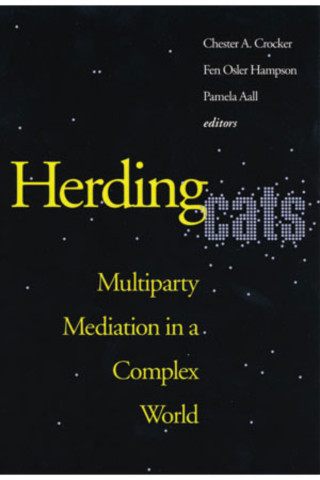An illustrious cast of practitioners here describe their personal experiences in working to bring peace in significant conflicts across four continents. As James Baker, Richard Holbrooke, Max van der Stoel, Alvaro de Soto, Aldo Ajello, and others make clear, the mediator must operate in an environment of daunting complexity, insecurity, and uncertainty. Whether sequestered in Norway or zigzagging across Africa, the mediator can take nothing for granted—not participants, agendas, or timetables—in the struggle to sustain and advance the peace process.
And just to make things more complicated, each conflict now typically attracts several independent mediators. Indeed, coordinating third party mediators is like herding cats—difficult if not impossible.
In each of the two dozen cases examined in this volume, mediation was a multiparty effort, involving a range of actors—individuals, states, international organizations, and NGOs—working simultaneously or sequentially. These vivid accounts attest to the crucial importance of coordinating and building upon the efforts of other players. They also illuminate the opportunities and problems presented by different entry points of mediation—from conflict prevention, through negotiation during active conflict, to post-settlement implementation and peacebuilding—and by different kinds of leverage, levels of engagement, and objectives.
This volume was developed by the same editors who were responsible for USIP Press's highly successful 1996 publication Managing Global Chaos and is intended as a follow-on to that book. In their feedback on the 1996 volume, readers requested additional resources, especially case studies that reflect real, hands-on experience in complex settings. Not only will these cases illustrate how multiparty mediation works or does not work, but they should also stimulate further work on the special requirements and best practices of the field, promote a dialogue among practitioners themselves as well as between academics and practitioners, and lead to unique insights, new understandings, and alternative approaches that can be applied to future mediations.
The editors have framed the volume with discussions that link the practitioner cases to the scholarly literature on mediation, thereby situating the case studies in terms of theory while also drawing lessons for both scholars and practitioners that can help guide future endeavors.
An invaluable resource for anyone seeking to grasp what makes for successful mediation and conflict management in an increasingly unmanageable world. . . . It will fascinate as well as educate the reader—whether student or practitioner.
Kofi A. Annan, UN Secretary General
Herding Cats is an extraordinary collection of the witness of practitioners trying to make peace in rough neighborhoods. . . . There is much to study and learn in this book, the best of the growing studies on mediation.I. William Zartman, SAIS

